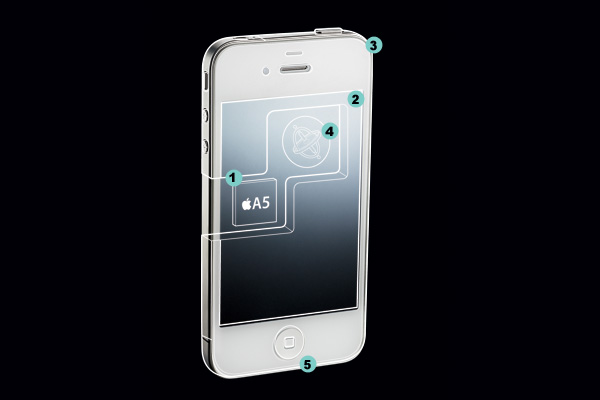By Pradeep Hunka
Software
The software in smartphones like iPhone can be considered as a software stack. The software stack in a smartphone consists of five layers. The layers include kernel, middleware, application execution environment (AEE), user interface framework and application suite. The kernel manages the processes and drivers for the hardware. The middleware consists of libraries that run the smartphone applications. The application Execution Environment provides an interface for application programming. The User Interface Network provides design and interface that is seen on the screen. Application Suite comprises the primary applications accessed by the users which include menu screen, calendar and message inbox.
Hardware
Processing Power
The smartphones run on processors with clock speeds ranging from 100-624 MHz (with 1 GHz processor) which is mind-numblingly slow if used on a desktop in today's times. Also, many smartphones have power-efficient processors which are also found in routers, printers and other embedded devices.
Computer chips
It is the chip that provides the smartphone functionalities which it exhibits. High resolution image sensors like digital cameras, real-time web-browsing, sharing multimedia files or playing music with low battery consumption are some of the functionalities which are possible because of the chip. There are innovations in the hardware with Apple's iPhone offering accelerometer wherein the view can be changed from landscape to portrait just by rotating the phone by 90 degrees.
Operating System
All smartphones are characterized by the operating system it is built on. The OS of the smartphone determines the functions, limits and range of applications a user would be able to access. There are two main platforms which are popular nowadays- Apple's iOS and Google's Android OS. Apart from these, Windows and Blackberry are also available in the market.
Technology
A smartphone needs to connect with a service provider. It makes use of the digital radio technology. The digital information is transformed into analog (binary data- series of one's and zeroes) and is compressed for easier transmission.
The enormous amount of data that a smartphone is able to handle is a result of the technology used in it called as Frequency shift keying, which utilizes two frequencies. Each frequency is assigned to a particular number in the binary series and switches from either 1 or 0 to send digital signal from phone to the transmission power.
Memory
There are two types of memory that are found in a smartphone. One is the internal memory and the other is the flash memory. The flash memory is like a hard drive and the device uses this memory for additional space to contain information stored in the smartphone.
Power
The smartphone gets its power from a rechargeable battery. The battery gets discharged when electrons move from negative to positive locations. Innovations are being done to reduce power consumption as much as possible. The feature of ambient light is present in iPhone in which the sensor helps the smartphone adjust the brightness of the screen according to the light present in the environment. The speed at which a smartphone restores its power depends on how much electrical current the charger allows to flow.
Smartphones have no longer become a luxury with the amazing features and applications that it brings to its users. Whether you are a gizmo freak or use it just to fulfill your basic necessities, a smartphone brings much more than what you expect from a mobile phone.
Hunka Technologies is a mobile phone application company that works on iPhone application and iPhone games. It also develops android applications and android games. The company has an iPhone apps development and iPhone games development team with more than 200 apps already uploaded at the iTunes Store. Its "Lock my Phone" app reached to #2 in overall categories at the Apple App Store.






0 comments:
Post a Comment